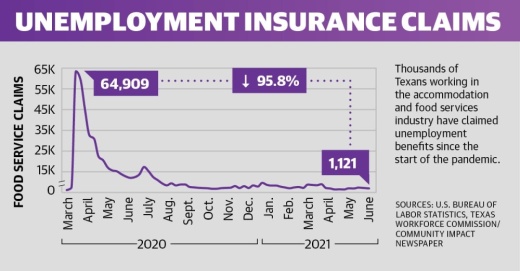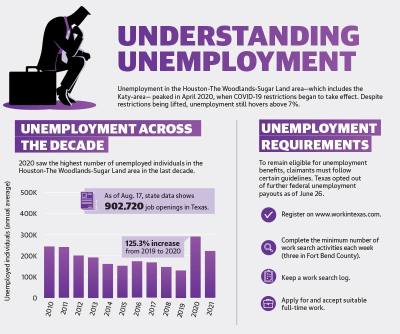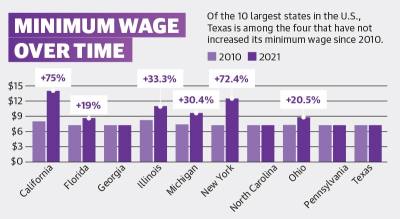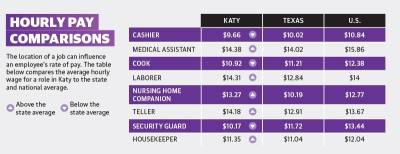“When school returns, the nightmare begins all over again, since most of my staff are college students,” she said.
Thaicoon has a hiring situation that mirrors other Katy-area businesses as well as employers across the state and nation as the pandemic continues and unemployment benefits have been reduced.
As of June, Texas’ unemployment rate was 6.5%, compared to 6.4% in May and 11.6% in June 2020, according to the U.S. Bureau of Labor Statistics. Unemployment rates in the Houston-The Woodlands-Sugar Land area were 7.4% in June and 11.6% last June. Data for July was not yet available as of press time.
Additionally, there were 902,720 job openings in Texas as of Aug. 17, according to Work in Texas, a Texas Workforce Solutions website. Despite the job availability, Matthew Ferraro, president of the Katy Area Chamber of Commerce, said he has heard of similar trends from the organization’s business members.
“They can’t find anybody,” Ferraro said. “They’ll get people to come in and interview, and they won’t hear back from them even if they’re offered the position.”
Unemployment payouts
In March 2020, the federal Coronavirus Aid, Relief and Economic Security Act established the Pandemic Unemployment Assistance program, which temporarily expanded unemployment benefit eligibility and provided an additional $300 a week.
Ferraro said he believes some of the applicants who do not show up for interviews could be trying to fill the quota of employment applications to remain eligible for benefits.
“I don’t know [if they do not show up because of] the federal side of them having to show that they’ve applied—that they’re continuing that unemployment process of showing that they’re looking for positions but still collecting unemployment,” Ferraro said.
The unemployment assistance program temporarily expanded unemployment benefit eligibility and was available to claimants who lost their jobs because of the coronavirus pandemic. To remain eligible, claimants must search for work according to the commission’s guidelines, such as completing one to three work searches per week and applying for work. Fort Bend, Waller and Harris counties require at least three searches per week to remain eligible.
“Maybe they’re adjusted to living off of the unemployment rates that they’re getting instead of going back to work,” Ferraro said.
He said he attributes the shortage to a variety of factors from pandemic benefits to child care.
“I think there’s so many factors,” Ferraro said. “It’s really difficult to pinpoint one specific reason or industry. I think everybody’s being affected, and I think there’s a ton of different reasons throughout.”
Many employers and economic leaders have attributed the hiring situation to federal pandemic unemployment payments they claim incentivize individuals to not work—benefits that Gov. Greg Abbott ended in Texas on June 26. Abbott cited an abundance of jobs as well as fraudulent unemployment claims when he announced the state would opt out of further benefits.
However, others said pointing the blame at unemployment benefits is mischaracterizing unemployed Texans as lazy and unwilling to work. Jonathan Lewis, senior policy analyst with Every Texan, a nonprofit that advocates to improve equity in health care, education and jobs, said he believes factors such as child day care, low wages and a lack of jobs that match employees’ skills can turn away job seekers.
“This characterization that workers are lazy is pretty damning,” he said. “If it’s just a $300 benefit that’s holding people back from accepting a job, [it’s] a pretty sad state of affairs.”
Rick Ellis, vice president of the Katy Area Chamber of Commerce, said the pandemic changed the unemployment landscape in a multitude of ways, including what factors people prioritize in their jobs.
“There are so many jobs that are out there, but a lot of these people just got spoiled,” Ellis said. “Staying at home, getting enhanced unemployment benefits from the government, not having to pay for child care, [not] commuting at all. They’re happy to be able to work and stay at home.”
On the rebound
Kerri Schmidt, president of the Fort Bend Chamber of Commerce, said staffing shortages are currently a main concern—adding Fort Bend County does have economic advantages over other areas in the state.
“As a board member of the Texas Association of Business and the Texas Chamber of Commerce Executives, I’m hearing about this concern from all over the state,” Schmidt said. “In Fort Bend County, we are fortunate to have an attractive region with great schools and rich amenities that continue to draw folks who want to live here.
This gives us an advantage over some areas of the state that may not be as attractive as Fort Bend.”
Additionally, Schmidt said despite the staffing challenges, unemployment in the county continues to decrease.
“We have certainly been in a recovery mode,” Schmidt said. “With every month we are getting closer to where we were prepandemic, which averaged at 3.5% in 2019. ... We are in a strong economic revitalization. We are seeing our businesses that were hit the hardest coming back to normal activity.”
In his statement about opting out of the unemployment assistance program, Abbott said the state should help unemployed Texans get jobs rather than paying unemployment benefits.
According to the TWC, there were nearly 60% more jobs open in Texas in May than there were in February 2020, before the coronavirus pandemic hit Texas.
“The Texas economy is booming, and employers are hiring,” Abbott said on May 17. “The number of job openings in Texas is almost identical to the number of Texans who are receiving unemployment benefits.”
However, Lewis likened cutting off federal benefits to “shooting yourself in the foot.”
“It doesn’t serve the Texas economy to force people into lower-paying jobs than what they were earning before,” he said.
Eri Noire, a Katy-area resident and Lone Star College student, said he was looking for a job for about a month that paid in the $12-$14 range. He recently took a role at a local car wash that pays $10 per hour—complemented by a second part-time job at Pizza Hut.
Noire said he has previous experience in overnight shelf stocking as well as working in car repair shops and warehouses. He said he was looking for a job that would pay the bills and work around his school schedule but felt the coronavirus pandemic has changed the job-hunting experience.
“The way of finding jobs now is not very interactive,” he said. “So you may not be able to show your full potential unless you’re offered an interview. I’d say the hurdle was the lack of personal connection between employers and job seekers.”
After a month, Noire said he had only received two interviews based on his applications.
“I know I can get a job—all I need is a chance, and I’ll most likely have it,” Noire said.
Brooke Ontiveros and Eva Vigh contributed to this report.








